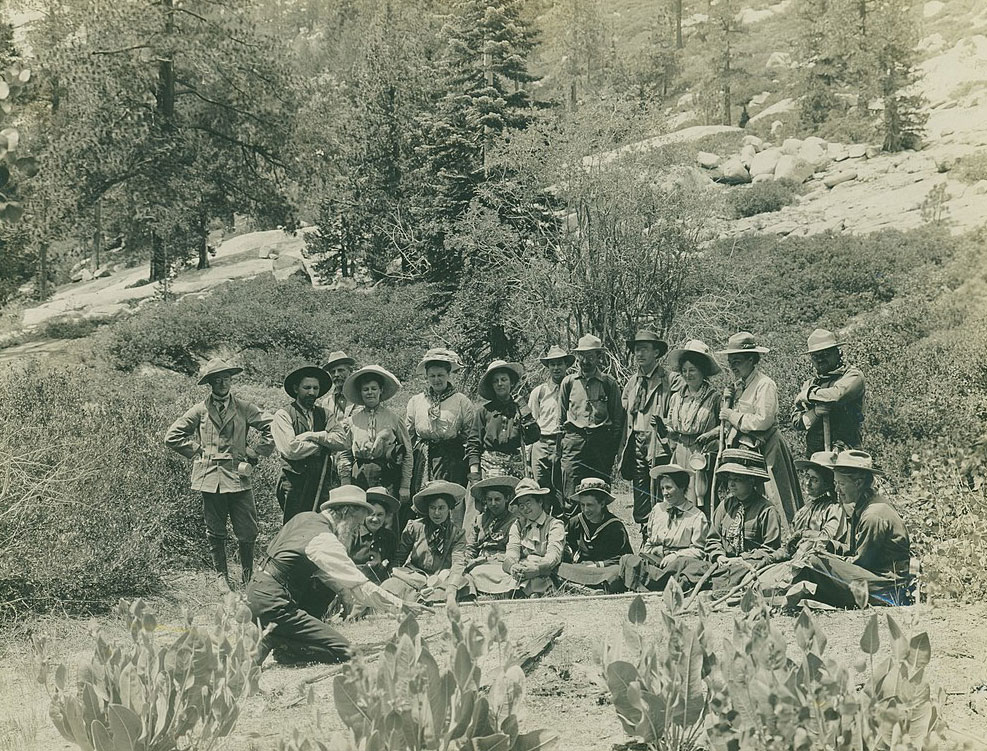
In a statement published last month on the Sierra Club website, executive director Michael Brune said the Sierra Club must “take this moment to reexamine our past and substantial role in perpetuating white supremacy.” Titled “Pulling Down Our Monuments,” Brune’s piece acknowledges the Sierra Club’s practice of lionizing founder John Muir and other early club leaders without commensurate acknowledgement of their well-documented racism and personal connections within the eugenics movement.
Though Brune’s commentary on John Muir got the headlines in the national media, what makes the piece a valuable exemplar of organizational communication about race is the specificity with which he describes the nature and consequences of racism at the Sierra Club—consequences that have lived on well past Muir’s death in 1914. In that specificity, we as readers and stakeholders experience a deeper accountability than we do, frankly, with the indistinguishable pablum of too many professionally crafted organizational statements.
Brune’s piece does three noteworthy things that can serve as inspiration to other nonprofit leaders not only for crafting public statements of accountability, but also for the broader work of building a multi-racial staff and board in a historically white dominant organization:
- Own Your History & Its Consequences
- Challenge Your Base
- Commit to Structural Change
Own Your History
Brune’s statement starts with a frank synopsis of organizational history. He explains how the organization’s origin story was imprinted with white supremacy:
In these early years, the Sierra Club was basically a mountaineering club for middle- and upper-class white people who worked to preserve the wilderness they hiked through—wilderness that had begun to need protection only a few decades earlier, when white settlers violently displaced the Indigenous peoples who had lived on and taken care of the land for thousands of years. The Sierra Club maintained that basic orientation until at least the 1960s because membership remained exclusive. Membership could only be granted through sponsorship from existing members, some of whom screened out any applicants of color.
Brune is describing, in effect, the early redlining of the environmental movement—the exclusion of non-white, non-middle and upper-class people and issues from membership in the club. That exclusion meant that even as the Sierra Club, like other national environmental nonprofits, was growing to millions of members, activists of color were creating the environmental justice movement to fight their own battles for protection from toxic waste dumping and other forms of environmental racism.
We need only re-read the incisive letter—now a part of environmental justice lore—sent on March 16, 1990, to Michael L. Fischer, then executive director of Sierra Club and nine other national environmental organizations that together called themselves the “Group of Ten.” Signed by 103 activists on Southwest Organizing Project letterhead, it declared:
Although environmental organizations calling themselves the “Group of Ten” often claim to represent our interests, in observing your activities it has become clear to us that your organizations play an equal role in the disruption of our communities….Your organizations continue to support and promote policies which emphasize the clean-up and preservation of the environment on the backs of working people in general and people of color in particular.
Thirty years ago, this letter outlined in great detail the kinds of environmental movement policies and practices that did immeasurable harm in communities of color. It also spoke directly to the corporate bedfellows of the “Group of Ten,” which included big oil, Dow Chemical, Coca-Cola, and others.
It is impossible for you to represent us in issues of our survival when you are accountable to these interests. Such accountability leads you to pursue a corporate strategy towards the resolution of the environmental crisis, when what is needed is a people’s strategy which fully involves those who have historically been without power in this society.
The exclusion of communities of color and activists on the frontlines of environmental justice from the mainstream environmental movement surely cost us years that we now know we did not have in the fight save people and the planet from climate change and its vast effects.
Sign up for our free newsletters
Subscribe to NPQ's newsletters to have our top stories delivered directly to your inbox.
By signing up, you agree to our privacy policy and terms of use, and to receive messages from NPQ and our partners.
Challenge Your Base
A second noteworthy aspect of Brune’s piece is that he is not suggesting that “pulling down the monuments” is sufficient; he does not let the current base of Sierra Club members and donors off the hook.
The whiteness and privilege of our early membership fed into a very dangerous idea—one that’s still circulating today. It’s the idea that exploring, enjoying, and protecting the outdoors can be separated from human affairs…The persistence of this misguided idea is part of the reason why we still get comments from our own members telling us to “stay in our lane,” and stop talking about issues of race, equity, and privilege. But as writer Julian Brave NoiseCat says, “The environment is no longer a white sanctuary. The messy business of society, power, and race is everywhere and intertwined.
As a chapter-based membership organization fueled in large part by volunteers, the Sierra Club has a powerful structural incentive not to challenge its base; that base is the primary source of its money, labor, and aggregate power. Instead, he calls out those who would hold the organization back, who refuse to see how issues of the environment and race are inextricably linked. By including that challenge in this public statement, Brune puts that element of the membership on notice that the organization does not intend to back down. It also serves to publicly validate the people within the organization who, he writes, “have had to push the Sierra Club to evolve for the better and to affirmatively place itself on the side of justice, often at great personal cost.”
Commit to Structural Change
In part two of their recent NPQ webinar series Beyond the Board Statement, consultants Robin Stacia and Vernetta Walker spoke to the essential qualities of a meaningful organizational statement on race and accountability, which includes commitment to specific actions that will yield different, more equitable results for the organization and its stakeholders over time. In that vein, Brune addresses who will constitute leadership at the Sierra Club going forward.
To begin with, we are redesigning our leadership structure so that Black, Indigenous, and other leaders of color at the Sierra Club make up the majority of the team making top-level organizational decisions. We will initiate similar changes to elevate the voices and experiences of staff of color across the organization. We know that the systems of power that got us here will not enable the transformational change we need.
Put simply, we cannot get to where we need to go next without significant de-centering of historically dominant voices and elevation of those who have been marginalized at the highest levels of organizational decision-making.
Brune further commits to reallocating financial resources to environmental and racial justice work and education of staff, volunteers, and members. And importantly, he commits to continuing the Sierra Club’s public dialogue about race in future blogs: “We’ll talk in much more depth about the steps we’re taking to rebuild the Sierra Club on a basis of racial and social justice and to try to repair the harm we’ve caused.”
In an interview with EarthBeat after the murders of George Floyd, Breonna Taylor and too many others, Robert Bullard—often described as the father of the environmental justice movement—spoke to the clear and present intersections of race and the environment:
And so, it’s one movement, and that movement is for justice. And it’s a movement to dismantle systemic racism that’s causing communities not to be able to breathe because they’re encircled with polluting chemical plants and refineries and other kinds of emissions. As well as the deadly choking of the breaths of unarmed individuals and taking those lives while people call “I can’t breathe.”
In 2013, the Sierra Club named Robert Bullard the winner of its most prestigious annual award: The John Muir Award. Then, in 2014, as grist reported, the Sierra Club created a new award to be given each year to “a person or group that has done outstanding work to help the people and communities most impacted by environmental degradation—people who have historically been overlooked and excluded by mainstream environmental groups.” They named it the Robert Bullard Award. And the work to make our social movements just continues.
I dedicate this article to the memory of my father, James Bell, who died last week. He taught me to love nature and justice.











